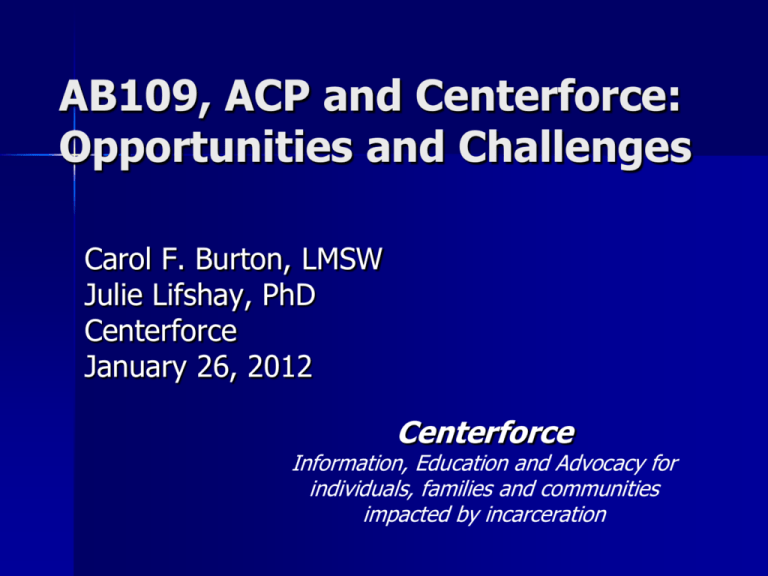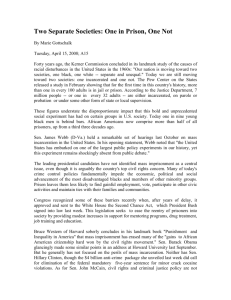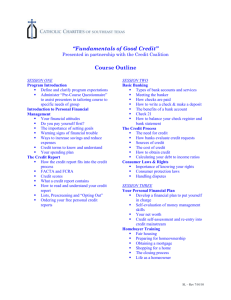AB109, ACP and Centerforce - California State University, Fresno
advertisement

AB109, ACP and Centerforce: Opportunities and Challenges Carol F. Burton, LMSW Julie Lifshay, PhD Centerforce January 26, 2012 Centerforce Information, Education and Advocacy for individuals, families and communities impacted by incarceration Why should you care?? • 1 in 32 adults in the United States is under some form of correctional supervision (jail, prison, probation, parole). (BJS, 2003) • That translates into approximately 7 million children. (BJS, 2003) • Under 1 year: 2% • 1-4 years old: 20% • 5-9 years old: 36% • 10-14 years old: 28% • 15-17 years old: 14% (Families Left Behind: The Hidden Costs Minority Children are Disproportionately Affected In State Prison-42% of fathers are African American and African American children are seven and a half times more likely to have a parent in prison than white children Percentage of incarcerated parents who NEVER had a visit from their child (BJS, 2000): 54% of mothers 57% of fathers Fathers by Age 80 70 60 50 State Prison Federal Prison 40 30 20 10 0 <24 25-34 35-44 45-54 55+ Children of Prisoners: Understanding the Risks and the Impact • Incarceration is rarely the only risk factor for a child with a parent in prison or jail. • Most have an “accumulation of risk”, multiple risk factors that occur in their families and communities. • The children’s response will vary according to age. • Older children are likely to act out—sexual misconduct, truancy, and substance abuse. • Younger children are at greatest risk because they have not developed the coping skills to deal with trauma. California’s Alternative Custody Program Largest women’s prison in the world Chowchilla houses 7,000 women ¾ of women are mothers © Centerforce 2012 8 ACP Female, pregnant or parents who immediately prior to incarceration were primary caregivers – Residential Home – Residential Treatment – Transitional Care facility – Monitoring through technology © Centerforce 2012 9 ALTERNATIVE CUSTODY PROGRAM FEMALE DEMOGRAPHIC ELIGIBILITY DATA - Per CSRA Score County(s) ELIGIBLE PER OISB** 79% * 1,584 1,251 Orange 389 307 Riverside 285 225 San Bernardino 554 438 San Diego & Imperial 318 251 177 140 213 168 402 318 310 245 551 435 354 280 5,137 4,058 Los Angeles Northern California Butte, Colusa, Del Norte, Glenn, Lake, Mendocino, Humboldt, Lassen, Modoc, Plumas, Shasta, Sierra, Siskiyou, Tehama, Trinity Southern Coastal Monterey, San Benito, San Luis Obispo, Santa Cruz, Santa Barbara, Ventura Bay Area Alameda, Contra Costa, San Francisco, San Mateo, Santa Clara, Marin, Napa, Sonoma Mid-Central Alpine, Calaveras, Mariposa, Merced, Mono, San Joaquin, Stanislaus, Tuolumne Central Valley Fresno, Inyo, Kern, Kings, Madera, Tulare Sacramento-Central Amador, El Dorado, Nevada, Sacramento, Placer, Solano, Sutter, Yolo, Yuba TOTAL Demographic information as of February 2011 * Random Sampling File Review Indicated Actual Eligibility to be 79% of OIS Pool ** Time period used was 0-24 months remaining in custody © Centerforce 2012 10 NUMBER OF FEMALE INMATES BY COUNTY – Top 10 Counties *as of 3/17/2011 (OISB) County # of Inmates Los Angeles 3,170 San Bernardino 830 San Diego 766 Riverside 668 Orange County 488 Sacramento 427 Kern 325 Fresno 281 Santa Clara 261 San Joaquin 201 Total 7444 © Centerforce 2012 11 AB109 Created three populations of offenders – Post Release Community Supervision (PRCS) – 3-NONS – State Parole Violators Community Corrections Partnerships (CCP) © Centerforce 2012 12 Challenges Things to Consider Parenting and Relationship education for custodial and non custodial parents Contact visits and other forms of communication with children and their incarcerated parent Programs that help parents (including non custodial parents reunite) © Centerforce 2012 14 Things to Consider Parents convicted of a felony are not eligible for TANF, Public Housing and have difficulty finding employment PRCS offenders are not eligible for services offered to paroles © Centerforce 2012 15 Health Issues Facing People who are Incarcerated © Centerforce 2012 16 There are many… Rates of HIV are approximately 5X higher than in general population – ~ A quarter [1/4] of PLWHIV/AIDS in the US pass through a correctional facility each year Rates of Hep C in CA prisons: – 40% of men; 50% of women upon entry are HCV+ (1999) Tuberculosis – Up to 25% of prisoners in the US have latent tuberculosis infection (LTBI) © Centerforce 2012 17 There are many… 43% (prisons) and 39% (jails) reported a chronic medical condition** (2009, 2006) – Statistically higher rates of asthma, hypertension, arthritis** DOJ estimates that ~50% of U.S. inmates have mental health problems >50% have history of substance abuse and addiction* A significant number of prisoners continue to use drugs, including injection drugs, during © Centerforce 2012 incarceration 18 The Cycle © Centerforce 2012 19 The Cycle Cycling between home and incarcerated settings means that – The care delivered by Correctional Health Services has important implications for the overall care of formerly incarcerated people in the community – Effective community re-entry support is vital for continuity primary care post-release – Re-entry/transitional and community health programs serving this community must communicate effectively to successfully support client needs © Centerforce 2012 20 Incarceration Experience Significantly different from the “free” community – Loss of Autonomy Privacy Possessions Ordinary, loving & sexual relationships Safety/Security Power Very stressful Health Care © Centerforce 2012 21 Re-entry Experience Experiences range from abrupt to drawn-out Stressful (positive and negative) – Individual, relationships, family (including children) – Competing priorities All ex-prisoners on probation must comply with probation conditions which may include securing stable housing or employment Health care needs often not addressed © Centerforce 2012 22 Re-entry Experience HIV positive prisoners are released with 7 to 30 days of AVT medications and in that timeframe must – Meet basic subsistence needs (e.g. housing, clothing, food, transportation) – Secure or re-establish primary care – for care and medications reimbursement sources (ADAP, Medi-Cal, VA etc) – Resist use of or relapse into use of alcohol/illegal substances The first month post-release is a critical period for HIV+ ex-prisoners who need strong support systems to support continuity of care and access to basic needs. © Centerforce 2012 23 Re-entry Experience Without access to treatment and care post-release, many health improvements achieved during incarceration may be lost. The overall instability that exists in the lives of many ex-prisoners hampers their ability to attend to their health care needs. – Most former prisoners return to the community with cooccurring housing and substance abuse related problems. – Complicating their access to health care are fragmented health care and correctional systems. © Centerforce 2012 24 Re-entry Experience Strong predictors of post-release primary care utilization & not recidivating include – housing stability – housing comfort – no alcohol use © Centerforce 2012 25 Responses Transitional Services Re-entry Case Management Discharge Planning Continuity Of Care Programs Discharge planning Continuity of Care Programs Transitional Services Re-entry Case Management © Centerforce 2012 26 Re-entry Case Management Discharge planning, transitional services, and continuity of care programs are essential for the vast majority of releasing ex-prisoners returning home. Case management may be particularly useful in helping high-risk clients engage in health-seeking behaviors (e.g. accessing primary care and substance abuse treatment services) © Centerforce 2012 27 Questions? Comments? © Centerforce 2012 28 Centerforce www.centerforce.org





